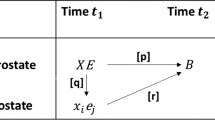Abstract
Recently advocates of the propensity interpretation of fitness have turned critics. To accommodate examples from the population genetics literature they conclude that fitness is better defined broadly as a family of propensities rather than the propensity to contribute descendants to some future generation. We argue that the propensity theorists have misunderstood the deeper ramifications of the examples they cite. These examples demonstrate why there are factors outside of propensities that determine fitness. We go on to argue for the more general thesis that no account of fitness can satisfy the desiderata that have motivated the propensity account.
Similar content being viewed by others
References
Ariew, A., & Lewontin, R. (2004). Confusions of fitness. British Journal for the Philosophy of Science, 55, 347–363.
Beatty, J. (1998). Fitness: Theoretical contexts. In E. F. Keller & E. A. Lloyd (Eds.), Keywords in evolutionary biology. Cambridge, MA: Harvard University Press.
Beatty, J., & Finsen, S. (1998). Rethinking the propensity interpretation: A peek inside pandora’s box. In M. Ruse (Ed.), What the philosophy of biology is: Essays dedicated to David Hull (pp. 17–30). Dordrecht: Kluwer Academic Publishers.
Bouchard, F., & Rosenberg, A. (2004). Fitness, probability and the principles of natural selection. The British Journal for the Philosophy of Science, 55, 693–712.
Brandon, R. (1990). Adaptation and environment. Princeton, NJ: Princeton University Press.
Charlesworth, B., & Giesel, J. T. (1972). Selection in populations with overlapping generations ii: Relations between gene frequency change and demographic variables. American Naturalist, 106, 388–401.
Demetrius, L. (1992). Growth rate, population entropy and evolutionary dynamics. Theoretical Population Biology, 41, 208–236.
Gillespie, J. H. (1973). Natural selection with varying selection coefficients a haploid model. Genetical Research, 21, 115–120.
Gillespie, J. H. (1974). Natural selection for within-generation variance in off-spring number. Genetics, 76, 601–606.
Gillespie, J. H. (1977). Natural selection for variances in off-spring numbers a new evolutionary principle. American Naturalist, 111, 1010–1014.
Humphreys P. (1985). Why Propensities Cannot Be Probabilities. Philosophical Review, (O 85) 94, 557–570.
Matthen, M., & Ariew, A. (2002). Two ways of thinking about fitness and natural selection. Journal of Philosophy, 49(2), 53–83.
Matthen, M., & Ariew, A. (2005). How to understand causal relations in natural selection: A reply to Rosenberg and Bouchard. Biology and Philosophy, 20(2–3), 355–364.
Maynard Smith, J. (1976). Group selection. Quarterly Review of Biology, 51, 277–283.
Millstein, R. (2006). Natural selection as a population-level causal process. The British Journal for the Philosophy of Science, 57, 627–653.
Rosenberg, A. (2006). Darwinian reductionism. Chicago, London: University of Chicago Press.
Salmon, W. (1984). Scientific explanation and the causal structure of the world (p. 205). Princeton, NJ: Princeton University Press.
Sober, E. (1993). The philosophy of biology. Boulder: Westview Press.
Sober, E. (2000). Two faces of fitness. In R. S. Singh, et al. (Eds.), Thinking about evolution: Historical, philosophical, and political perspectives (pp. 309–321). Cambridge: Cambridge University Press.
Walsh, D., Lewens, T., & Ariew, A. (2002). Trials of life: Natural selection and random drift. Philosophy of Science, 69, 429–446.
Wright, S. (1943). Isolation by distance. Genetics, 28, 114–138.
Wright, S. (1945). Tempo and mode in evolution: A critical review. Ecology, 26, 415–419.
Wright, S. (1969). The theory of gene frequencies, volume 2 of evolution and the genetics of populations: A treatise in three volumes. Chicago: University of Chicago Press.
Acknowledgments
We would like to thank the following for comments on previous drafts: Frédéric Bouchard, Sara Rachel Chant, Mohan Matthen, Michael Strevens, Elliott Sober, Denis Walsh, and audience members of a session of the American Philosophical Association in San Francisco, 2007 where we presented a draft of this paper.
Author information
Authors and Affiliations
Corresponding author
Rights and permissions
About this article
Cite this article
Ariew, A., Ernst, Z. What Fitness Can’t Be. Erkenn 71, 289–301 (2009). https://doi.org/10.1007/s10670-009-9183-9
Received:
Accepted:
Published:
Issue Date:
DOI: https://doi.org/10.1007/s10670-009-9183-9




